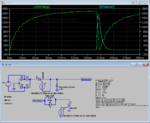Zak28
Advanced Member level 2

Follow along with the video below to see how to install our site as a web app on your home screen.
Note: This feature may not be available in some browsers.




Clearly improper topology. Without the permanently connected rectifier circuit, the SCR is extinguished when the capacitor voltage falls below zero and the coil current commutates to the diode. Charge current must be interrupted during capacitor discharge time, e.g. by a second SCR. Or use MOSFET switch, as discussed in your previous thread: https://www.edaboard.com/showthread.php?377126-Misbehaving-thyristor-with-ltspice-simulationIs it particular scr or improper topology which is causing latching?

...current must be interrupted during capacitor discharge...


This IMHO is not a problem of not_available_devices. It rather is a problem of how you do the search.The trouble with fets is me being unable to find a single fet with an soa capable of handling volts/amps/duration of pulse.





A GTOSCR can...

It's not possible by present design of the circuit.The other option might be to make the circuit resonant so that discharging the cap ends up going below zero long enough to get the SCR to quench.
Unfortunately you didn't yet understand the problem of your circuit and the suggested correction. See how it works.I believe the only viable option here is either disconnect cap from SCR whilst it charges or use a transistor.


It's not possible by present design of the circuit...

Hardly. Just read, which part is the answer referring to? IGBT or SCR? I have written about transistor switch (MOSFET/IGBT) option before.Did you mean to say using IGBT inplace of SCR for original iteration wont work?


...the huge mains current peaks...


Inductor would be preferred.

